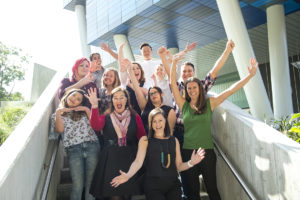Lead researcher
Jared Mamrot
Main finding
We conducted extensive next-gen sequencing on 24 different organs from the spiny mouse. We then took all of the nucleotides and assembled them into a large catalogue of gene sequences. The process we used to do this was unique: we were the first to use this method in a mammal, and we have published our protocol for others to use (https://dx.doi.org/10.17504/protocols.io.ghebt3e). We have also made our data available to all researchers: we have built a website for BLAST searching the assembled transcripts (http://spinymouse.erc.monash.edu/sequenceserver/) and the raw data is available from the NCBI. This reference assembly is an important new resource for spiny mouse research, and increases the value and accessibility of this species as an animal model in biomedical science.
Centre
The Ritchie Centre
Research group
Dr Hayley Dickinson - Embryology and Placental Biology lab
Journal and article title
Most surprising
Many aspects of this project were novel/new – we used novel methods to build our reference-quality assembly and this is the first characterisation of spiny mouse genes in the literature.
I was surprised by the amount of work involved in this project. Our original plan was to use the ‘standard’ protocol used in bioinformatics to conduct the assembly, however we quickly discovered that the outcome produced was subpar and didn’t fulfil our needs. To try and improve on the standard method I spent a year at the Walter and Eliza Hall Institute in their bioinformatics department learning the statistical and mathematical methods involved in the assembly process. We were ultimately successful in applying novel methods to achieve a high-quality result, however it has taken 7 years from conception to get to this endpoint.
Future implications
Our lab, collaborators, and other research groups are now using this resource in their research. We are currently working with the Bill and Melinda Gates Foundation to validate the spiny mouse model for accelerating research into female reproductive disorders, and we have entered into a commercial partnership with a tier-1 pharmaceutical company to test novel contraceptive compounds. Our transcriptome is helping to facilitate this research.
Disease/health impact
Reproductive diseases - We use the spiny mouse (Acomys cahirinus) to model various human diseases and we recently discovered spiny mice display a very unusual characteristic: they have a menstrual cycle (not an estrus cycle like >98% of mammals). This discovery suggests spiny mice are better than traditional lab rodents (rats and mice) for modelling reproductive diseases and disorders such as endometriosis, premature ovarian failure, PCOS, dysmenorrhea, and to investigate side effects from drugs such as contraceptives. If we are successful in validating the spiny mouse as an accurate model of these human diseases we can accelerate pre-clinical testing of novel treatments. In order to validate the spiny mouse model we need to characterise their basic physiology: this transcriptome assembly provides the first insight into which genes are expressed in the spiny mouse and how they are regulated.
Other points of interest
I was very surprised by the interest this project generated within the scientific community. We chose to post this paper as a preprint on bioRxiv before submitting it for publication and many people discussed it on Twitter and other social media platforms; it was also mentioned in a Nature article on the spiny mouse (http://www.nature.com/news/first-rodent-found-with-a-human-like-menstrual-cycle-1.20072). This unexpected exposure was incredibly beneficial: we received feedback from leading bioinformaticians on our method, and their advice significantly improved the quality of the assembly and the manuscript. I strongly encourage all students in the institute to start using Twitter, follow scientists, and tweet about your work – it has been one of the best things I’ve done in my PhD.


